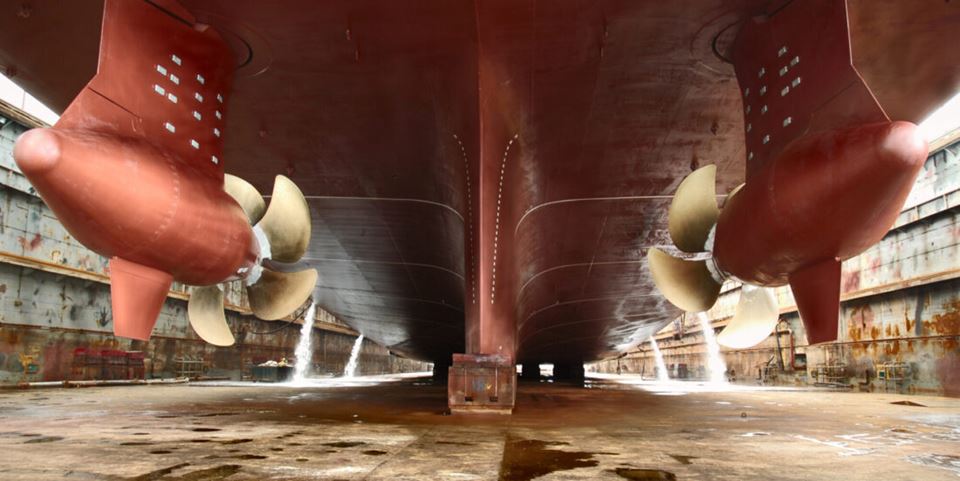Viewpoints express the writers’ opinions.
The International Maritime Organization, or IMO – the “UN” of shipping – is aiming for ships to have zero emissions by 2050. Today, the world has more than 100 000 commercial vessels. The footprint of this giant fleet is not only determined by engine emissions.
From a life-cycle perspective, the choice of maintenance methods also has a major impact on shipping’s CO2 emissions.
Today, it is widely accepted and agreed that repairing large components on ships, such as propellers, is always more climate-friendly than replacing them. However, the analyses we have conducted show that there are actually exceptions when we look at propellers through a “cradle-to-grave lens.”
Golden rule with exceptions
Propellers are among the largest individual components on ships. On land, the world’s largest ship propeller would reach up to the gutter of a four-story apartment building.
In our analyses, we delved into the world of propellers. We found that the circular economy’s golden rule that reuse is greener than scrapping does not always apply here.
The study shows that replacing a Norwegian-made propeller with a replacement propeller that is also Norwegian results in a lower CO2 footprint than when a Chinese propeller is repaired in China.
- You might also like: How penguins’ air tricks could help the shipping industry
Energy mix is decisive
Electricity, it turns out, is a significant input factor both when propellers are manufactured and maintained.
Thus, a propeller from a hydropower country will have a lower CO2 footprint than a propeller made in a country where coal power dominates the energy mix.
The footprint for repairing propellers, work that is done using advanced 3D printing methods, varies in exactly the same way. The more renewable energy is in the energy mix of the country where the repair is done, the lower the CO2 emissions over the propeller’s lifetime will be.
If a worn propeller requires repair, our study shows that the CO2 footprint is a full 40 percent lower if the job is done in Norway (98 percent hydropower in the energy mix) than if the repair is done in China. That is because fully 80 percent of China’s electricity is estimated to be from coal power.
Life cycle analyses are important
Our figures cannot be transferred to other large components, either on ships or on land. These analyses are only valid for ship propellers.
However, since the differences we demonstrate are so large between countries, we recommend that work on life cycle analyses be intensified for a wide range of industrial products.
Only through such studies can we measure climate effects over the life of products when the choice is between repair and replacement.
- You might also like: Standing tall, the ship is taller than the Eiffel Tower
Advanced versions of 3D printers
Ship propellers are made using corrosion-resistant materials like bronze, brass or stainless steel to cast propeller blades in sand moulds.
Repair work is done using machinery for Directed Energy Deposition (DED), which is an advanced 3D printing method.
The technique is particularly effective in repairing damage and wear on large components. The DED technique deposits layers of metal powder that are then heated. This makes it possible to replace metal that has worn off from propeller blades.
On a mathematical model journey
In our study, we analysed the entire life cycle of the materials used in ship propellers.
We first looked at the energy use starting from mining at one end, via smelters, foundries, DED-based repairs and the production of metal powder, to the recycling of metal at the end of the propeller’s life.
We then fed all this information into a mathematical model and let raw materials and finished propellers go on a journey, some over long distances. In the calculations, we transported raw materials from the USA, Norway, China and the Czech Republic to propeller foundries in Norway, Germany and China. Using the calculations, we then sent ships to the same three countries to have propellers repaired.
In all the scenarios minus one, repairing the propellers is the most climate-friendly option. We have already mentioned the exception: When both the original propeller and the replacement one are Norwegian, replacing propellers has a lower CO2 footprint than when Chinese propellers are sent for repair in China.
Key to increased competitiveness
Cost is currently the most important factor when choosing a scheme for ship maintenance. But if the shipping industry is to manage to reduce its emissions to zero by 2050, it must shift to emphasizing the climate effects of different forms of maintenance.
All environmental measures, large or small, would be welcome in such a process.
Of great importance for the climate footprint would be for nations’ energy mix to become a criterion for deciding where maintenance should be carried out. Shipping companies that choose to implement such a measure will strengthen their reputation, and thus their competitiveness, in the future shipping market.
This Viewpoints article was first published in Teknisk Ukeblad and is reproduced here with TU’s permission.



